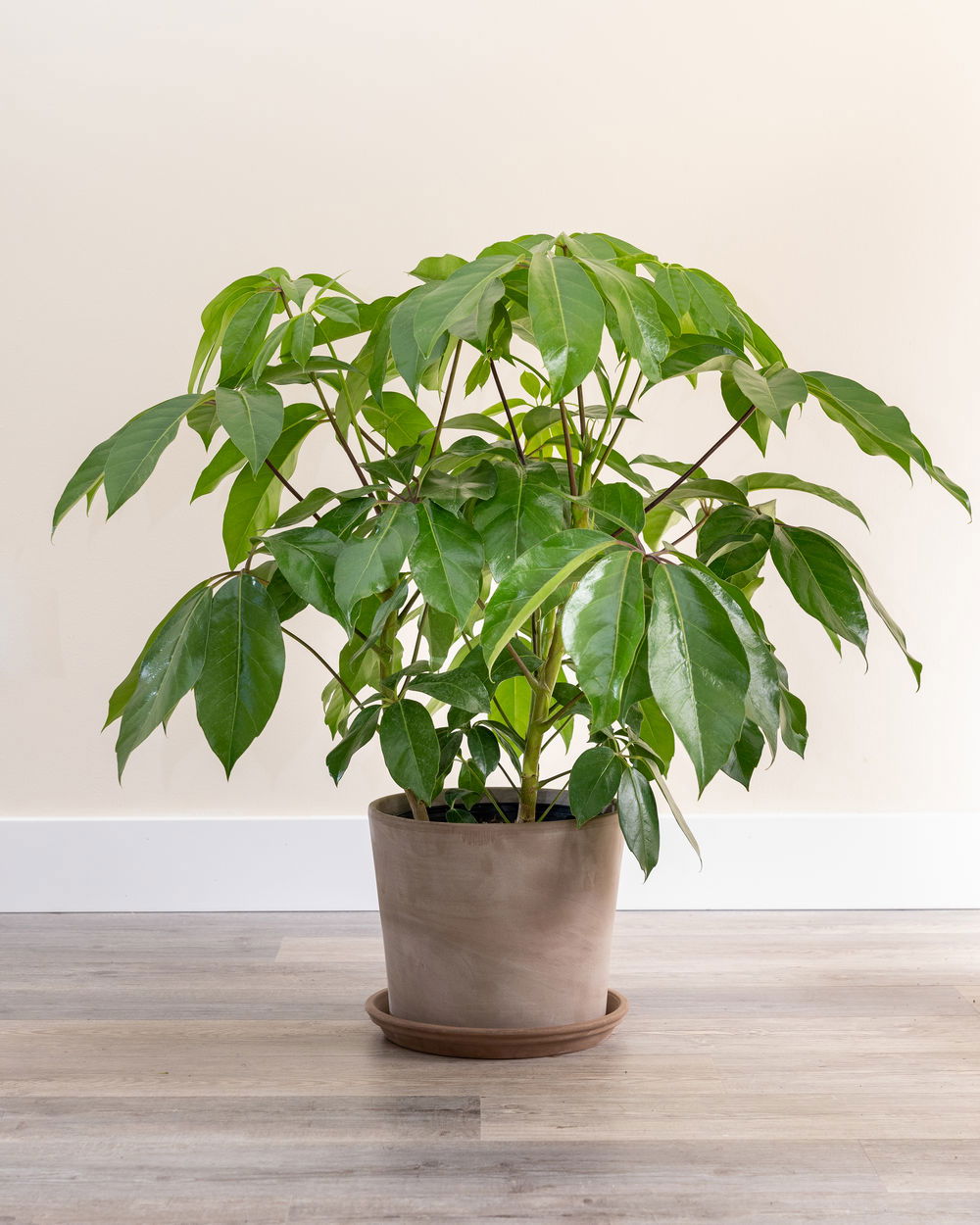
Schefflera actinophylla. Copyright: PlantVine
Contents
- Top Tips
- Location, Water, Humidity & Fertilisation
- Common Issues
- Origins, Temperature, Propagation, Repotting & Toxicity.
Are you struggling to find the answer to your specific plant issue? Book a 1-to-1 video call with THE HOUSEPLANT DOCTOR™, the website's friendly author, to put an end to your stress today! Available on iMessage, WhatsApp, Facebook Messenger & more.
Top Tips & Info
- Care Difficulty - Moderate
- Australian Umbrella Trees would prefer to be situated in a location that offers bright light with the possibility of morning sunlight. Rapid lower-leaf drop or variegation loss are caused by low light.
- Allow the top third of the soil to dry out in between waters, reducing this further during the winter.
- Fertilise using a 'Houseplant' labelled feed every four waters in the spring and summer, reducing this to every six water in the colder months.
- Repot every three years using a well-draining potting mix and the next sized pot with drainage holes. We recommend using 'Houseplant' labelled compost.
- Keep an eye out for Mealybugs and Scale that’ll sit in the cubbyholes of the plant.
Location & Light - 🔸🔸🔸
A position that offers a splash of morning or evening sun is best, especially during the autumn and winter months. Avoid more than two hours of direct sunlight a day during the summer, as this will lead to dehydration and sun-scorch. Rapid leaf loss will occur to plants that are placed in too dark locations - if it's too difficult to read a book, it'll be too dark for the plant, too!
Water - 🔸🔸
During the spring and summer, maintain good soil moisture by only allowing the top third to dry out in between irrigations - reduce this further during the colder months for the replication of its dormancy period. Australian Umbrella Trees situated in darker locations must be watered far less than those located in brighter ones for the prevention of root rot. Under-watering symptoms include stunted growth, dry spots appearing on the leaves and yellowing older leaves; these issues are either down to an over-crowded pot, too little light, or forgetfulness. Over-watering symptoms include yellowing lower leaves, brown mushy patches developing in the stems, and root rot. For the latter, take the plant out of its pot and investigate the health below the soil line. If there are visible signs of rot, click on this link to learn about the recommended steps to eradicate this problem.
Humidity - 🔸
Low humidity won't affect an Australian Umbrella Tree too much, as long as you occasionally mist the foliage whilst the radiators are operating. A gentle hose-down once a month will help with the hydration of leaves, but will also wash off any excess dust and pests.
Fertilisation - 🔸🔸
Feed every four waters during the growing period, and every six waters for the rest of the year. Never use a 'ready to pour' fertiliser into the soil without a pre-water beforehand as it'll quickly lead to root-burn. It's recommended to use a 'Houseplant' labelled product as it'll provide a good blend of the thirteen essential nutrients for quality growth.
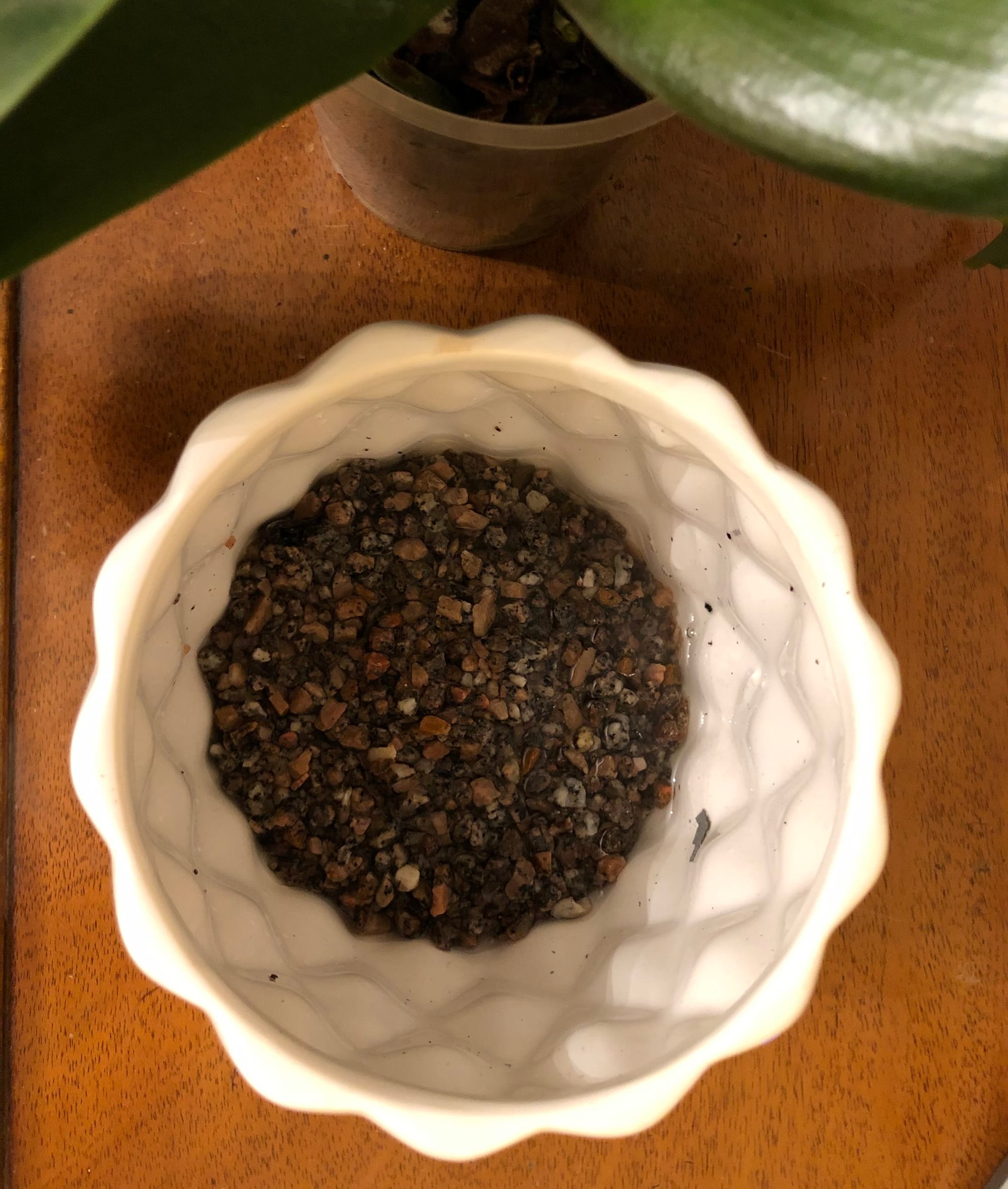 If you're forgetful with watering or battling with dry air, why not fill the decorative pot's bottom sixth with small grit? This will promote more reliable soil moisture that'll help encourage better growth & all-round health as the excess moisture will drain from the plant's plastic pot, thus creating a humid environment for root interaction.
If you're forgetful with watering or battling with dry air, why not fill the decorative pot's bottom sixth with small grit? This will promote more reliable soil moisture that'll help encourage better growth & all-round health as the excess moisture will drain from the plant's plastic pot, thus creating a humid environment for root interaction.
Common Issues with Australian Umbrella Trees
Pest damage and Umbrella Trees go hand in hand. Check the leaves' undersides and along the central archways (midrib) for possible infestations of Scale. Along with the brown ovular shells, they'll produce a shiny sticky substance that'll develop on the top sides of the leaves - this is what's known as sooty mould. Click on the hyperlink above to learn more about how to eradicate this pest.
Spider Mites are another common pest, with small near-transparent critters slowly extracting the chlorophyll from of its leaves. Have a check under the leaves, most notably along the midrib, for small webs and gritty yellow bumps. Other symptoms include the yellowing of leaves, crisped leaf-edges and a general decline of health. Click here to read our article about the eradicating spider mites, along with some extra tips that you may not find elsewhere!
White dusty markings on your Umbrella Tree are just mineral deposits from hard water. If you live in an area with this, try using an aquatic water softener like 'Seachem Prime' that'll remove hard metals, minerals and chlorine. You can also use this to wipe the leaves to remove the dusty markings.
Gradual leaf loss is a natural behaviour for Australian Umbrella Trees as it ages, but if there is a sudden drop of foliage (more than five leaves per week), it could be a sign of not enough light. Especially when the plant has been relocated or purchased recently, this is a behavioural trait that'll continue to happen until there are no more leaves remaining. THE HOUSEPLANT DOCTOR™ recommends placing the plant into a brighter area, like a north or east-facing windowsill or by a glass door for best results.
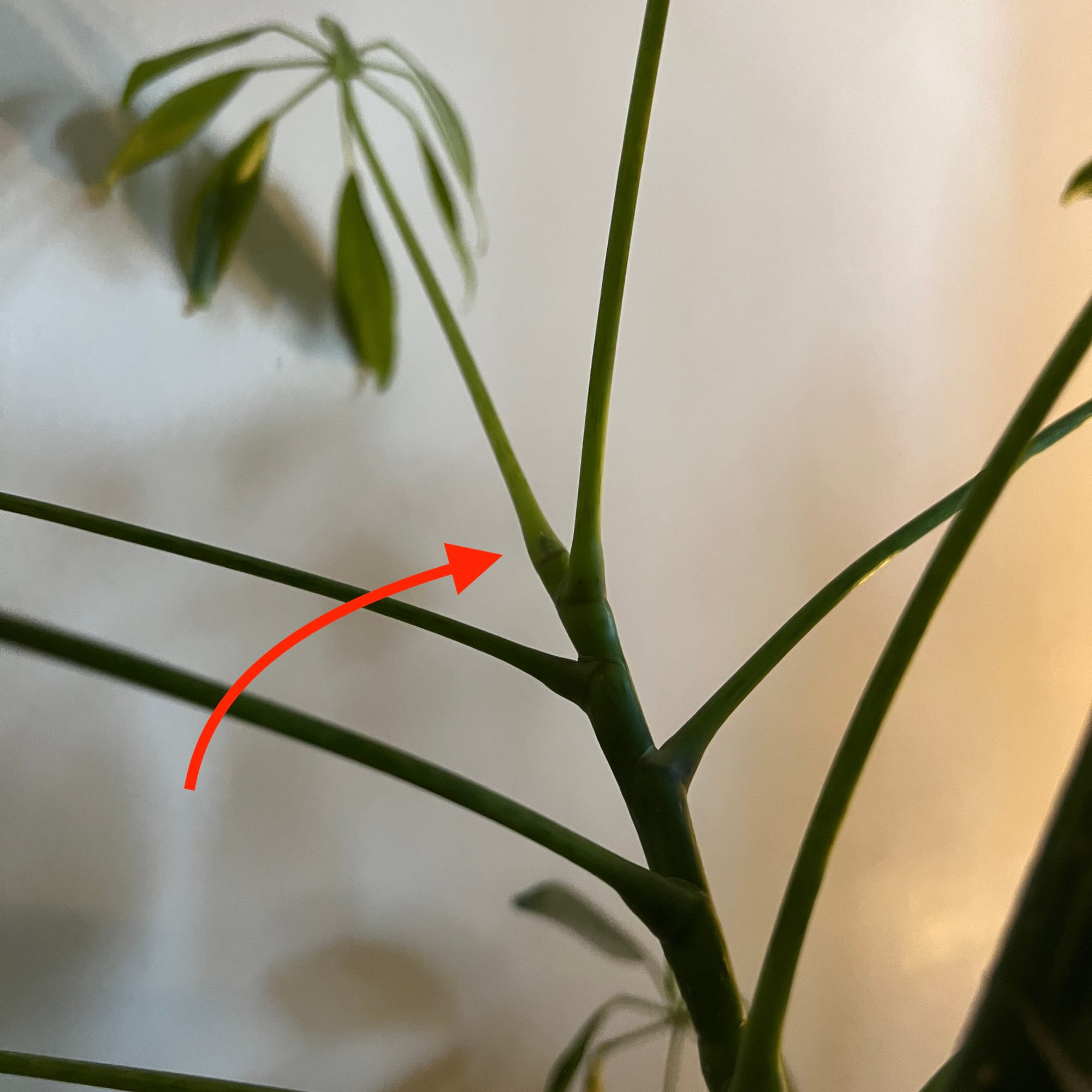 You'll know when an Australian Umbrella Tree is in a dormancy period as there'll be no growth emerging from the stem's tip. Keep the plant well-fed & provide a location within 2m (6ft) of a window if yours hasn't grown in three months.
You'll know when an Australian Umbrella Tree is in a dormancy period as there'll be no growth emerging from the stem's tip. Keep the plant well-fed & provide a location within 2m (6ft) of a window if yours hasn't grown in three months.
Low light will cause new growth to develop with an absence of variegations. If you're not overly bothered about this texture, keep the plant where it is, or relocate it into a brighter location.
Environmental Shock is a familiar occurrence with newly-located specimens, that usually results in stunted growth and lower leaf loss (common). When a plant is relocated into a new, unfamiliar setting, the effects can be catastrophic. The humidity, temperature and light levels will all suddenly shift into different proportions, inflicting great stress the individual. There are two options of addressing this issue; either wait it out or relocate it into a more Umbrella Tree-friendly environment. As long as the specimen appears healthy with little change to its pre-existing leaves, new nodular growth should emerge in the following months.
Yellowing lower leaves is a clear sign of over-watering, commonly sped up by too little light. Although non-variegated specimens can do well in low light, irrigations must be reduced to counteract the chance of root rot. This soil-borne disease is the breakdown of the root systems that'll inhibit the plant's ability to soak up moisture and vital nutrients for growth, thus resulting in wilting and yellowed leaves.
Always use lukewarm water, and if you choose to use tap water, allow it to stand for at least 24hrs before application. Their root systems tend to be quite sensitive to temperature change, so pouring cold tap water into the pot will not only ironise the roots, but could even cause yellowed halos around each leaf.
Transplant shock is a big issue when it comes to repotting; give the plant a good soak 24hrs before the action and never tinker with the roots, unless it has been affected by root rot. Typical signs of transplant shock are largely similar to under-watering (wilting, yellowing leaves and stunted growth). For more information about addressing this issue, click on this link and scroll down to the 'Transplant Shock' section!
Origins
Schefflera is part of the Araliaceae family that holds genera such as Polyscias, Fatsia japonica and Hedera. In 1775, the genus was named after Johann Peter Ernst von Scheffler, an 18th-century German physician and botanist who contributed to the Reygers books on botany.
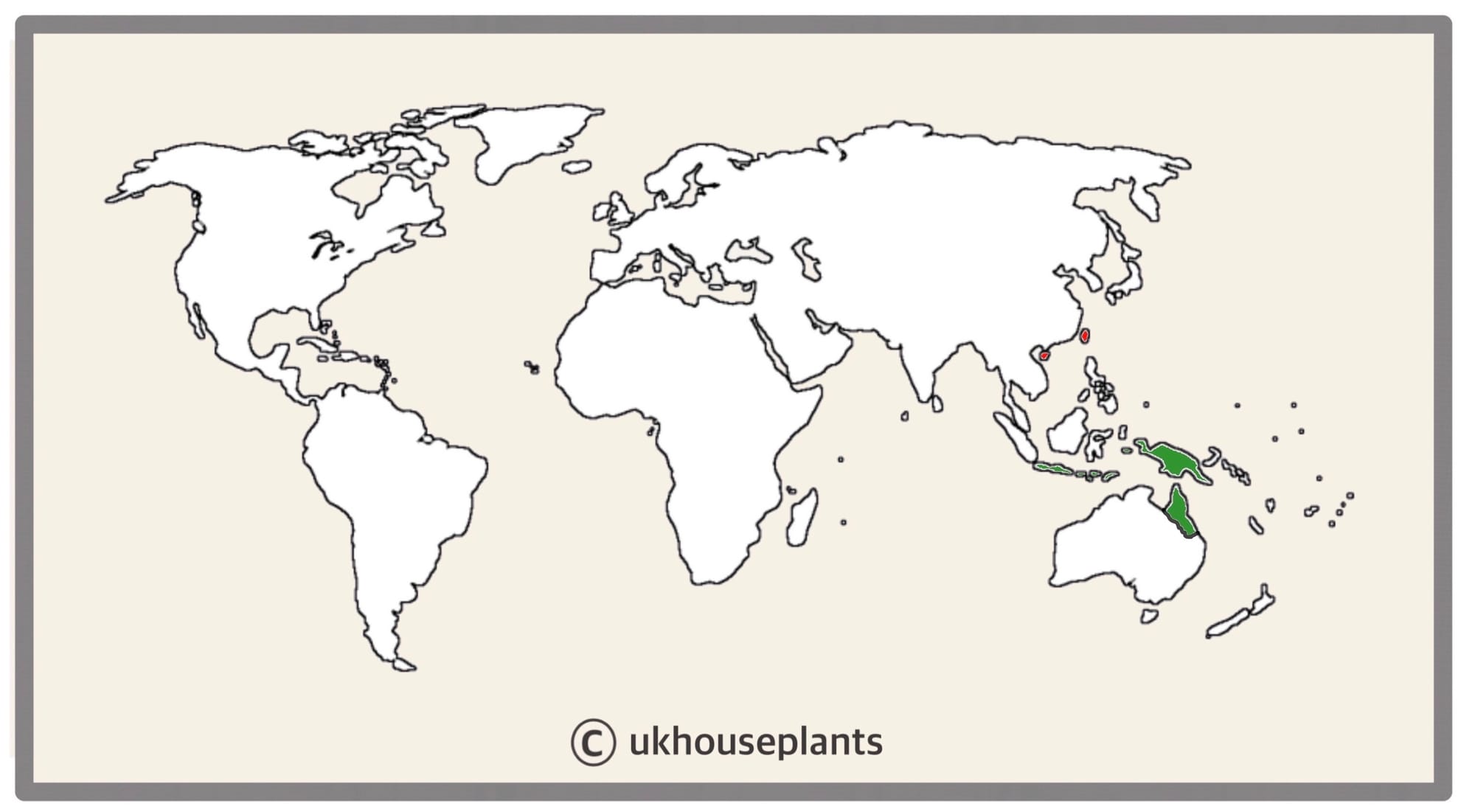 A Distribution Map of the two most popular Schefflera, the S. actinophylla (Green) & the S. arboricola (Umbrella Tree) in Red.
A Distribution Map of the two most popular Schefflera, the S. actinophylla (Green) & the S. arboricola (Umbrella Tree) in Red.
Temperature
10° - 23℃ (50° - 75℉)
H1c (Hardiness Zone 12) - Can be grown outdoors during the summer in a sheltered location with temperatures above 10℃ (50℉), but is fine to remain indoors, too. If you decide to bring this houseplant outdoors, don't allow it to endure more than an hour of direct sunlight a day as it may result in sun-scorch. Regularly keep an eye out for pests, especially when re-introducing it back indoors.
Spread
Up to 4m in height and 1.4m in width when grown indoors. The ultimate height will take between 5 - 10 years to achieve, with 20cm of growth being put out annually.
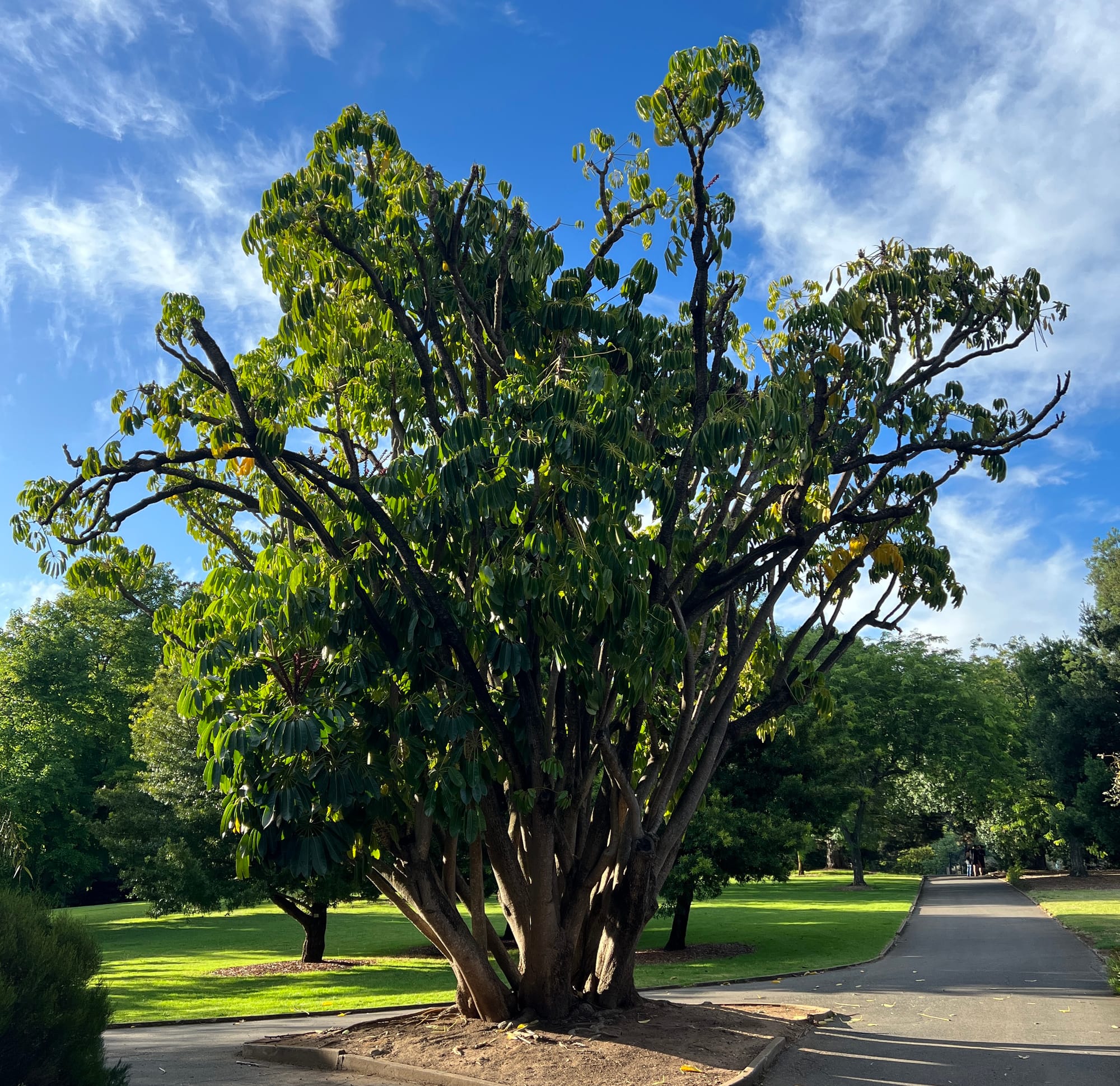 Those who live in warmer climates can grow Australian Umbrella Trees outdoors all year round in their gardens or parks.
Those who live in warmer climates can grow Australian Umbrella Trees outdoors all year round in their gardens or parks.
Pruning & Maintenance
Remove yellowed or dying leaves and plant debris to encourage better growth and improve the all-round appearance. Pruning must be done with clean scissors or shears to reduce the chance of bacterial and fungal diseases; remember to make clean incisions as too much damage can shock the plant.
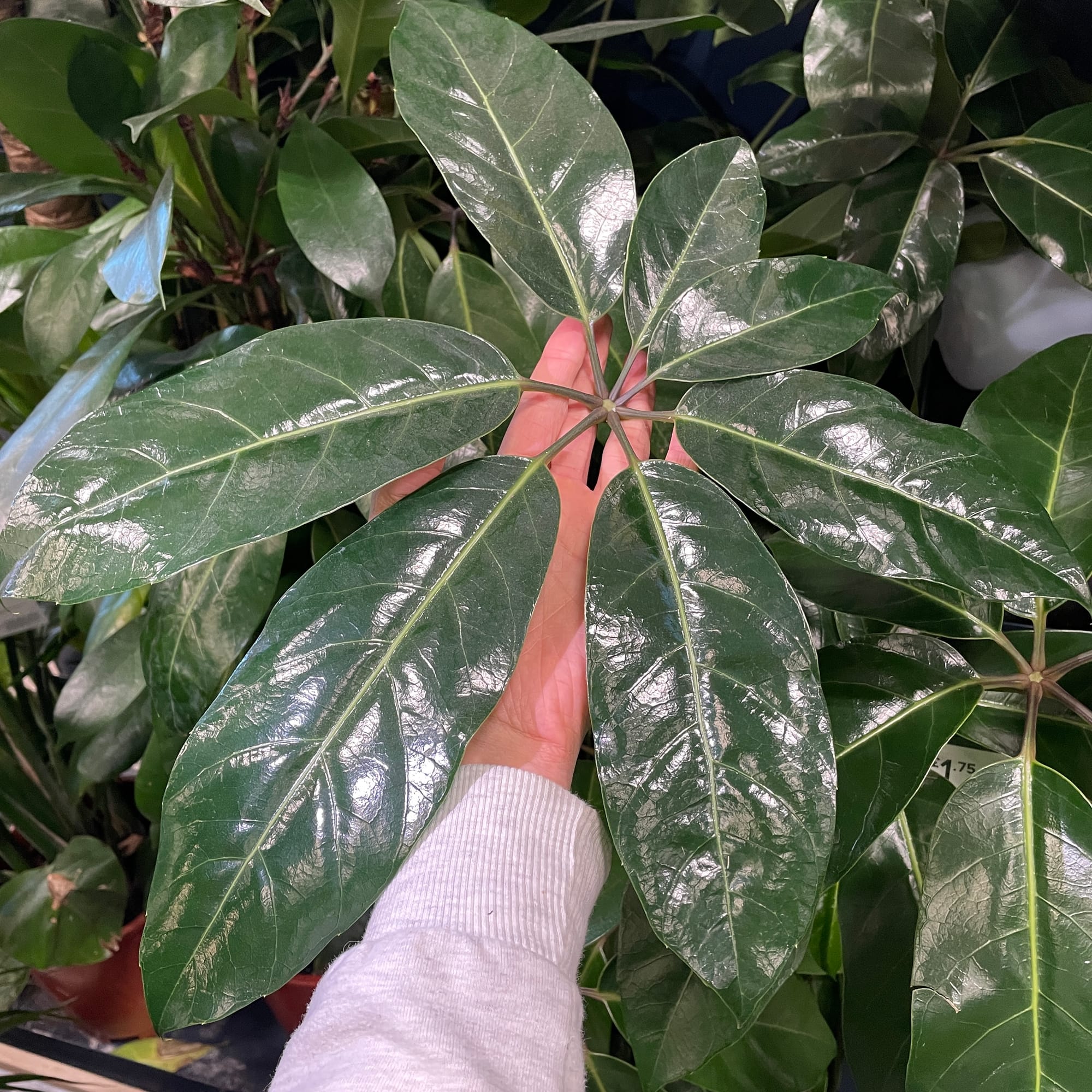 Always keep your Umbrella Tree's leaves clean from dust to increase photosynthetic rates by using a damp cloth soaked in just warm water.
Always keep your Umbrella Tree's leaves clean from dust to increase photosynthetic rates by using a damp cloth soaked in just warm water.
Propagation
Via Seed or Stem Cuttings.
Stem Cuttings (Difficult)
- Hygiene is the most crucial element of successful propagation. The secateurs must be dirt-free with a fresh (or well stored) batch of compost. As you'll be cutting through vulnerable tissue, using uncleanly equipment will introduce harmful pathogens to the cutting and its mother plant.
- For stem cuttings, the best specimens are those located at the leading growths. You should aim for a semi-wooded base, but still juvenile enough to slightly bend with the diameter of a pencil. Never use diseased or weakened growth, as it is likely to fail.
- Make the best incision possible to prevent the development of disease and remove the bottom half of the leaves.
- Decide on rooting the cutting via water or soil. The first option tends to have better success, especially if you're a new-time propagator. Remove any rotten debris and replace the water every ten days with lukewarm tap water to prevent shocking the plant. Although collected rainwater is acceptable, the risk of harboured diseases is too high, especially with an open wound. Once the roots surpass 3cm (1.1 inches), you can safely pot them up. For both options, use an aerated soil that has a fluffy texture with some perlite, too. Never use a poorly stored bag of compost as it'll promote larvae or perennial seeds to arise. ukhouseplants would recommend using 'Houseplant Compost' with a 7cm (3 inches) pot that has adequate drainage holes.
- Place a 2cm (0.8 inches) layer of soil at the bottom of the pot, and then rest the cutting vertically in the middle - you may have to hold it for support.
- Fill the compost around the cutting, making sure that its bottom half is submerged. Do NOT press or compact the soil. Condensing it to support the cutting will push the oxygen above the soil line, suffocating the roots until they rot. If it needs support, introduce a cane or something that won't lead to compaction!
- Place the potted cutting in a transparent bag or box. Because of the lack of roots, it'll start to lose stored water - very quickly. A confided environment will lock-in the humidity and reduce the rate of transpiration (water loss through the leaves).
- You'll rarely have to water the soil due to the moist air. If it compacts itself after the first irrigation, level it out by adding more compost.
- Open the bag every few days for fresh air, but be sure to keep the soil evenly moist and NOT soggy - if it looks saturated, leave it! The surrounding humidity in the container will do its job by hydrating the leaves and its stem.
- Situate it in a bright, indirect location away from any heat sources (i.e. radiators). Keep the temperature around 18℃ (64℉) as this is the optimum temperature for root development - you can even use a bottom-heat pad to speed-up the process. The roots will develop BEFORE the foliage. You can safely remove the bag or box once new leaves emerge, as, at this point, there'll be a sufficient root system. Introduce a pebble tray to maintain a good level of atmospheric saturation and to reduce the severity of environmental shock
- Keep the soil moist and maintain a bright, indirect location away from direct sunlight and other heat sources. After around six months, transplant into a slightly bigger pot, keeping in mind transplant shock (where the root hairs are damaged or over-touched). For more information on how to perform the perfect transplant, click here!
Flowers
Pink flowers will appear several times during its lifespan, but will only bloom once it reaches a certain level of maturity. Blooms are formed in clusters that will develop into yellow berries if pollination is successful. The whole plant, including the berries, is highly toxic due to the heightened levels of calcium oxalate crystals.
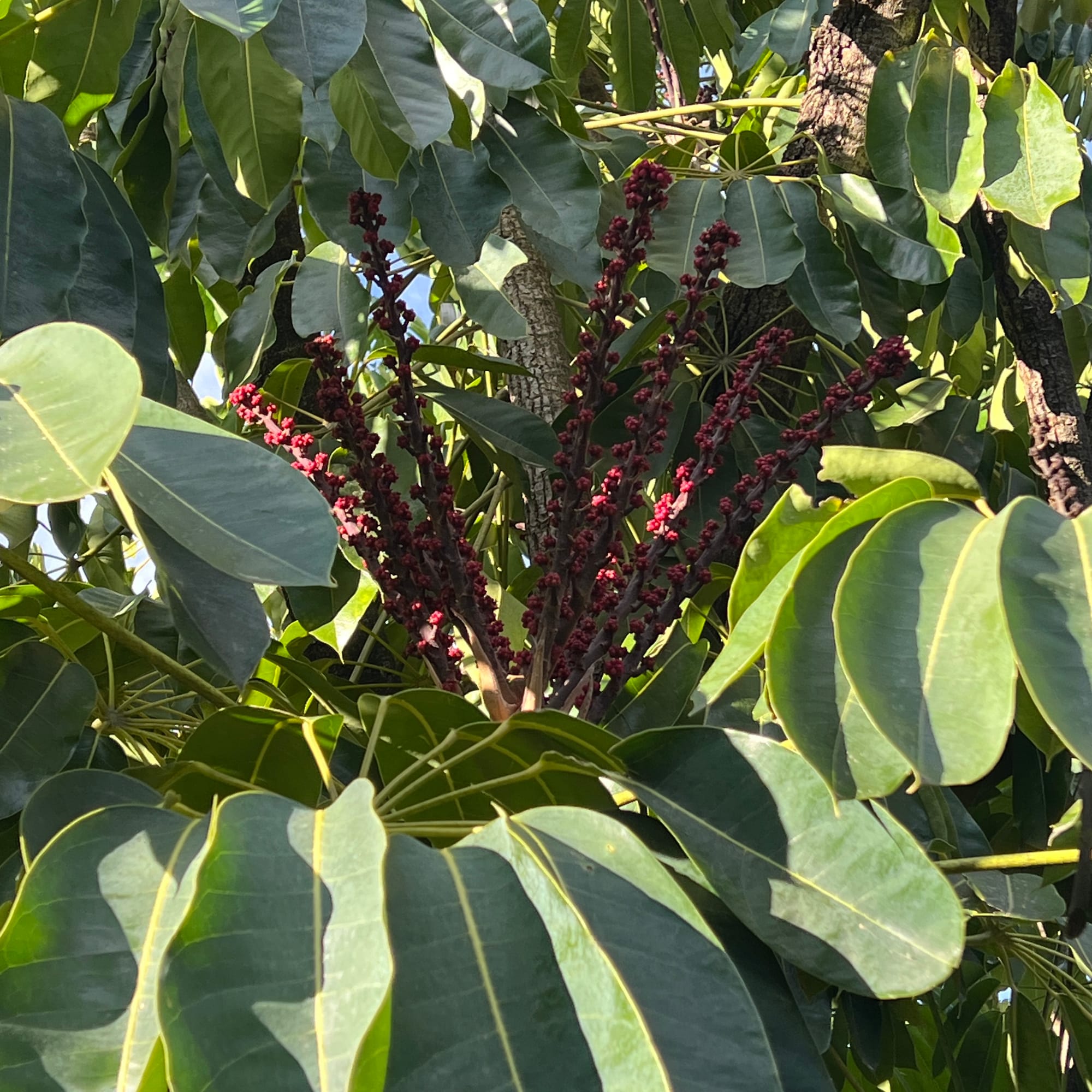 Unfortunately it's rare for an Australian Umbrella Tree to flower indoors, as it'll take many years to reach maturity. The photo above is a 7m tall tree growing in Adelaide's botanic garden, pictured in late spring.
Unfortunately it's rare for an Australian Umbrella Tree to flower indoors, as it'll take many years to reach maturity. The photo above is a 7m tall tree growing in Adelaide's botanic garden, pictured in late spring.
Repotting
Repot every two years in spring using a 'Houseplant' labelled potting mix and the next sized pot with adequate drainage. Australian Umbrella Trees are far better being potbound for several years due to the heightened risk of root rot and repotting-issues (like transplant shock), so only repot if you feel it's wholly necessary - restricted root growth will also increase the chance of blooms, too.
Hydrate the plant 24hrs before tinkering with the roots to prevent the risk of transplant shock. For those situated in a darker location, introduce an extra amount of perlite and grit into the deeper portion of the pot to downplay over-watering risks. Click here for a detailed step-by-step guide on transplantation, or via this link to learn about repotting with root rot.
Pests & Diseases
Keep an eye out for scale, aphids, spider mites, vine weevils & mealybugs. Typical diseases associated with Australian Umbrella Trees are leaf-spot disease, botrytis & root rot - click here to learn about these issues.
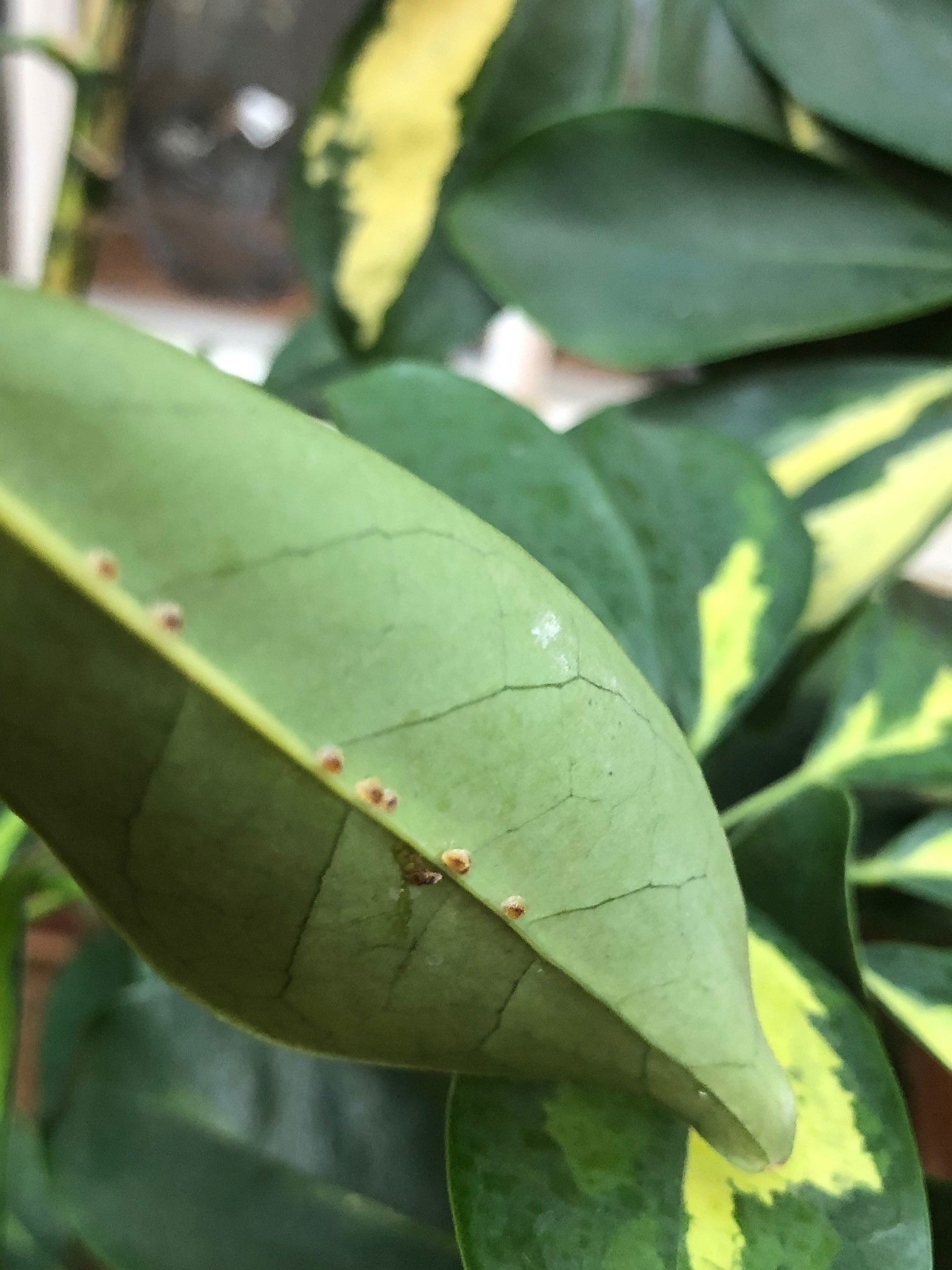 Scale is a big issue among growers. Shiny, sticky leaves is the first tell-tale sign of an infestation.
Scale is a big issue among growers. Shiny, sticky leaves is the first tell-tale sign of an infestation.
Toxicity
This plant is classified as poisonous, so if small sections are eaten, vomiting, nausea and a loss of appetite may occur. Consumption of large quantities must be dealt with quickly; acquire medical assistance for further information.
Retail Locations
Dobbies, Blue Diamond, British Garden Centres, Waitrose Garden & Online Stores.
Book a 1-to-1 Call with THE HOUSEPLANT DOCTOR™
If you need further advice with your houseplants, book an advice call with ukhouseplants' friendly and expert writer today! This can be done via a video or audio call on most apps, including Facebook, FaceTime & Skype. A ten-minute call costs £5.99 (US$7), or £15.99 for thirty minutes. You can ask multiple questions, including queries on plants, pests, terrariums, repotting advice and anything in between. Please consider supporting this service to keep ukhouseplants thriving!